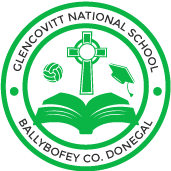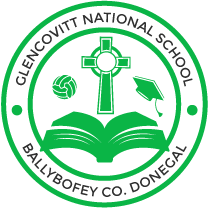Physical Education Policy
Introductory Statement and Rationale
(a) Introductory Statement
This P.E. policy was formulated by the staff of Glencovitt National School on 19th March 2019 on review of the existing policy dated June 2005.
(b) Rationale
Physical education provides children with learning opportunities through the medium of movement and contributes to their overall development by helping them to lead full, active and healthy lives. We aim to provide these learning opportunities to the children in our school to maximise active learning experiences and approaches to the benefit of each individual child.
Vision and Aims
(a) Vision
We seek to assist the children in our school in achieving their potential by the promotion of physical activity throughout the school in accordance with the Active School Flag programme. In Glencovitt N.S., we work in a multi-class environment and so seek to tailor the curriculum and lessons bearing in mind our facilities and class groupings. We intend to reinforce the seven key messages of the Primary PE curriculum in our lessons.
Key Messages
- The importance of enjoyment and play.
- Maximum participation by all children.
- The development of skills and understanding.
- A balance between competitive and non-competitive activities.
- Providing opportunities for achievement of each child.
- Providing activities equally suitable for boys, girls and children with
additional needs.
(b) Aims
To experience enjoyment and achievement through movement and develop positive attitudes towards physical activity which will contribute to life-long health and fitness, and use of purposeful leisure time.
- To develop qualities of self-esteem, self –awareness, confidence, initiative and leadership through movement.
- To develop an understanding of fair play and team spirit through participation and competition.
- To help in the acquisition of an appropriate range of movement skills in a variety of contexts, i.e. speed, strength, agility, flexibility etc in athletics, dance, gymnastics, games and aquatics.
- To develop an appreciation of movement and the use of the body as an instrument of expression and creativity.
- To promote understanding and knowledge of the various aspects of movement.
- To adapt safe practices in all physical activities.
- To continue to participate in the Active School Flag initiative.
- To encourage members of the Active School committee to take responsibility and show initiative promoting our Active School environment.
- To report to parents on their children’s progress in the area of P.E.
- Through use of our termly newsletter, Active School notice-board & website to keep parents updated with regard to the Active School programme & activities.
Methodologies:
Among the teaching approaches which are currently particularly appropriate for teaching physical education are
- The direct-teaching approach: teacher telling and showing
- The guided-discovery approach: teacher asks questions to promote learning
- Integrated approaches: enrichment through other subjects
- Peer modelling: Do your talking while you’re walking, playground games etc.
- Station teaching enables all pupils to participate in an activity, providing opportunities for continuous practice for groups working on different tasks at the same time.
Assessment and Record Keeping
Teachers are continually assessing the students’ performance in P.E. through teacher observations and teacher designed tasks. The students are assessed on their willingness to perform, interest, enthusiasm, skill level and willingness to co-operate.
Information gained from the assessments forms part of class and school planning. Records of a child’s P.E. progress are recorded in end of year reports. Feedback is also shared with parents at Parent/teacher meetings in November.
The Curriculum
The strands/strand units/content objectives for the relevant class levels are found in the curriculum documents. In our school we have children with various needs. We support these children in our lessons.
Teachers will choose a range of activities for all strands for each class. All six strands will be covered each year – Athletics, Dance, Gymnastics, Games, Outdoor and Adventure Activities and Aquatics.
Equality of Participation and Access
- In planning for P.E. we are going to pay attention to the following areas in order to promote gender equity throughout the physical education curriculum.
- All children from infants to sixth class will partake in all six strands of the curriculum where possible.
- When grouping children for physical education the school will endeavour not to group children solely on the basis of gender whenever possible.
- We acknowledge the special place that Gaelic Games hold in our culture and therefore Gaelic Games should be given particular consideration as part of the Games programme.
- Special needs children will be encouraged to participate fully in our P.E. programme where possible. Lessons and activities will be adapted to cater for their needs and abilities. We will adapt our physical activities to accommodate the interests and needs of our children with special needs. Where possible we will source specialised P.E. equipment to cater for their particular needs. This will be implemented in consultation with the S.E.T., Class Teacher, SNA and child.
- Every child will have access to all P.E. activities provided by the school and lack of financial resources on behalf of the child will not hinder their participation.
- The B.O.M. has given permission to charge a nominal fee to each child for certain activities. No child will be denied access to lessons. e.g. Swimming due to lack of financial resources.
Linkage and Integration
(Refer to Curriculum page 13 ) and (18, 37, 45-47 Teacher Guidelines)
- Linkage:
Linkage can take place within physical education for example many playground games can be planned as part of an athletics or games unit; athletics as part of games activities; orienteering incorporating games. - Integration:
Integration is planned and organised by staff through planning and is regularly used in Gaeilge, Drama, SPHE and Music among other subjects. Theme based activities are used to support integration by staff when possible. They will be recorded on fortnightly plans. - Language:
The school creates opportunities for pupils to discuss and talk about their own and others’ performance in P.E. during and after the P.E. activity e.g. “What skills did you learn?”
We enable children to develop a vocabulary for discussing and critiquing P.E. activities through similar discussions.
Organisational Planning: Timetable
We ensure that all pupils receive one hour of Physical Activity per week in line with the Primary P.E. Curriculum Guidelines. As much as possible, we will follow a standardised P.E. timetable. Specific months of the year will be designated to the teaching of certain strands (Appendix 1). Our school organises many activities throughout the school year incorporating physical activities, e.g: Seachtain na Gaeilge, Easter egg hunt, Maths trails etc. (See Appendix 1 for yearly plan overview as a whole school approach.)
The school facilitates an “Active School Week” whereby the discretionary curriculum time for the period in question is used to promote physical activity for all children in the school encompassing as many of the strands of the P.E. curriculum as possible. During ASW, pupils will be prescribed physical activity tasks as homework. Local sporting clubs and groups are invited to the school to introduce the children to a variety of sporting activities. We invite a variety of specialist coaches who have skills or interests in a particular physical activity. We are currently working to earn an Active Schools Flag in 2019 for promoting an active lifestyle, formally and informally among our pupils. The Project is coordinated by Mr. Herron and Ms. Timoney.
Playtime
All children are encouraged to play and enjoy their break times. During break times, our motto, “Do your Talking While you’re Walking’’ is strongly advocated and monitored by the supervising teachers and SNA. We encourage a variety of games at break times. There are yard markings on the yard allowing the children create their own games. We also take out a variety of sports equipment during breaks and have designated areas of the yard to different activities. We also participate in “Football-Free Fridays” to encourage children to explore different activities and sports during playtime.
Health and Safety
We have a school Health and Safety Policy which will be adhered to at all times in P.E. activities. Issues identified as being health and safety issues in a P.E. context include warm-up at the start of all physical activity, practising in confined spaces, use of equipment, accidents, supervision, activities involving the whole school yard, procedures for dealing with accidents …etc It is important to acknowledge from the beginning that while the following procedures will eliminate unnecessary hazards they cannot remove all risks due to the physical nature of the subject. When engaging children in P.E. all members of staff will ensure that the following safety aspects will be taken into consideration
- All children should wear suitable footwear and clothing during a P.E. lesson. Children are prohibited from wearing any jewellery during a P.E. lesson.
- The equipment used will be suitable in size, weight and design to the age, strength and ability of the child and be of good quality and in good repair.
- In all P.E. lessons, children will warm up and cool down. This develops good practice and the children will return to class relaxed after activity.
- Should an accident occur in the P.E. lesson we will follow the procedures outlined for other accidents in our Health and Safety policy.
- Best practice is safe practice and the teacher should ensure that the children understand that the rules and procedures are there for their safety.
- We will endeavour to have an appropriate surface for the activities in the P.E. lesson
- Children will not be forced to do activities they are not physically or mentally ready for.
A First Aid Kit is kept in the main office along with the incidents book for recording any injuries.
Success Criteria
- How will we know that the plan has been implemented?
- Teachers’ preparation based on this plan.
- Procedures outlined in this plan consistently followed.
- Has the plan achieved its aims? What are the indicators? (Refer to Aims)
- Means of assessing the outcomes of the plan include.
- Teacher/parent/community feedback.
- Children’s feedback regarding the activity level, enjoyment and skill development of the classes.
- Inspectors’ suggestions/report.
- Second level feedback.
- Has the plan promoted the key considerations when implementing a programme of Physical Education?
- The importance of enjoyment and play.
- Maximum participation by all children.
- The development of skills and understanding.
- A balance between competitive and non-competitive activities.
- A balance between contact and non-contact activities.
- Providing opportunities for achievement for each child.
- Providing activities equally suitable for girls and boys.
Implementation
Roles and Responsibilities
The Principal will co-ordinate the progress of the plan, encourage and accept feedback on its implementation and report to staff on findings. The plan will be monitored and evaluated every year. We can reflect meaningfully on how well the P.E. programme has been taught and received in the school. The following will be consulted in appraising the P.E. plan:
- Teachers
- Pupils
- Parents
- BOM/DES Inspectorate
Ratification and Communication
The P.E. plan has to be ratified by the Board of Management and parents can inspect the plan on the school website.
Ratified by the Board of Management at its meeting in May 2019.
Signed______________________________ Date________________
To be reviewed 2020.
Policy was reviewed and ratified at the Board of Management meeting on 6th October 2022.




